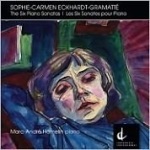Sophie-Carmen Eckhardt-Gramatté (1899-1974) was a violinist, pianist, and prolific composer who left behind a catalog of more than 175 symphonic, chamber, violin, and piano works. A foundation in Eckhardt-Gramatté’s name was established in Winnipeg (where she composed and taught for the last 21 years of her life) to promote her work, including the six piano sonatas recorded by Marc-André Hamelin for Altarus in 1990. Happily, the Canadian Music Centre has reissued these long-out-of-print recordings.
The music abounds with energy, restless counterpoint, unbridled harmonic activity, and orchestral textures in the form of big chords and stamina-testing octaves. The early First sonata (1923) finds the young composer at a curiously appealing stylistic juncture where baroque counterpoint and Spanish Romanticism meet. The more harmonically complex Second sonata evokes Rachmaninov’s whirling passion and Busoni’s thick-textured polytonality. The Russian/Spanish fusion comes to full flower in the Third (1924-25) and Fourth (1927-31) sonatas, notably in the Third’s second-movement Rondo, where a scintillating right-hand perpetuum mobile over a pounding left-hand ostinato brackets a gorgeous, lyrical chordal section.
The Fourth’s third movement is a large-scale toccata in F-sharp minor for the left hand alone, although the right hand comes to the rescue in the final measures. By contrast, the Fifth (1950) in three continuous movements incorporates twelve-tone composing techniques, and is terser, craggier, and more compressed in form and expression. The Sixth (1928/1951/1952) is a hybrid of sorts. It opens with the aforementioned Fourth sonata left-hand Toccata, but with a rewritten ending. Fast forward 23 years later to a relatively atonal second-movement fantasia for right hand alone, followed by a third and final movement that freely combines the previous movements, ingeniously weaving their disparate styles into a surprisingly organic and fluid patchwork.
It goes without saying that the young Marc-André Hamelin’s staggering mastery, control, and poise made the best possible case and set reference interpretive standards for this fascinating repertoire. Highly recommended to Hamelin fans and for those who enjoy traveling the virtuoso piano repertoire’s obscure yet worthy scenic routes. [8/11/2011]
































